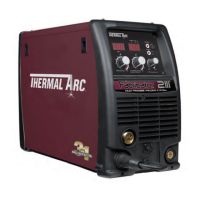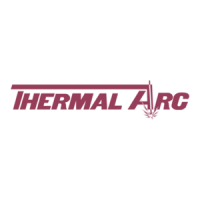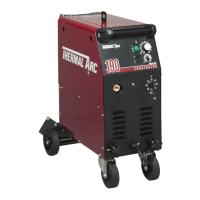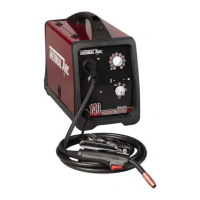Do you have a question about the Thermal Arc FABRICATOR 210 and is the answer not in the manual?
Details hazards associated with electric shock during arc welding.
Lists key industry standards for safe welding and cutting practices.
Explains various symbols used on the welding machine and in the manual.
Provides safety precautions for arc welding in French.
Describes hazards related to arc welding in French.
Lists principal safety standards in French.
Provides a symbol chart in French.
Instructions on how to effectively use the service manual.
Information on locating and identifying the welding unit's model and serial numbers.
Overview of the Fabricator 210, its design, and compliance with standards.
Outlines essential basic safety rules to follow when operating the welder.
Details the importance and selection of protective filter lenses for eye safety.
Defines the user's responsibilities regarding the equipment's installation, operation, and maintenance.
Explains the concept of duty cycle and its importance for operating the power supply.
Provides detailed technical specifications for the welder and its components.
Lists all the components included in the Fabricator 210 package.
Refers to optional accessories available for purchase.
Specifies suitable environmental conditions for operating the welder.
Guidelines for selecting an appropriate location for the power supply.
Emphasizes the importance of adequate ventilation for welding areas.
Details the necessary input power, voltage, and fuse requirements.
Information on changing voltage settings and required lead specifications.
A brief guide for quickly setting up the welder for operation.
Step-by-step instructions for installing the shielding gas system.
Procedures for adjusting the gas flow rate using the regulator/flow meter.
Instructions for connecting the MIG gun cable and assembly to the welder.
Steps for installing the wire guides for proper wire feeding.
Guidance on selecting and installing the correct drive rolls for different wire types.
Instructions on how to properly install a wire spool onto the machine.
Step-by-step process for feeding the welding wire into the machine's feedhead.
How to adjust the pressure of the drive roller for optimal wire feed.
Instructions on adjusting the brake on the wire reel hub.
Details on how to connect and use an optional spool gun.
Instructions for changing the welding polarity of the output terminals.
An overview of the welder's front panel controls, indicators, and features.
Explains how to select different welding modes like 2T, Spot, and Stitch.
Details the dwell time control for stitch welding operations.
Describes the burnback control function and its adjustment.
Helps identify different versions of the MIG gun supplied with the welder.
Information about the TWECO Weldskill 250A Fabgun MIG gun and its parts.
Step-by-step guide for installing or replacing the wire conduit in the MIG gun.
Routine maintenance procedures for the MIG gun to ensure proper wire feeding.
Guidance on setting up the power supply and basic welding techniques.
Explains the optimal distance between the MIG gun nozzle and the workpiece.
Factors influencing the choice of electrode wire size for welding.
Discusses the benefits of using a forehand welding technique.
Instructions for performing stitch welding operations.
Details on how to perform spot welding using the welder.
Guide for selecting the appropriate shielding gas for different welding applications.
Recommendations for welding settings based on material type, wire, and gas.
Outlines the basic maintenance and inspection procedures for the welder.
Basic troubleshooting steps that can be performed without special knowledge.
Addresses common welding problems and their solutions.
Troubleshooting guide for issues related to inconsistent wire feeding.
Detailed solutions for various welding issues like undercut, lack of penetration, etc.
Troubleshooting guide for common power supply issues and their remedies.
Outlines the specific warranty periods for different components and product types.
| Input Phase | Single Phase |
|---|---|
| Input Frequency | 50/60 Hz |
| Welding Processes | MIG, Flux-Cored, Stick |
| Wire Feed Speed | 50 - 700 IPM |
| Wire Feed Speed Range | 50 - 700 IPM |
| Welding Amperage Range | 30-210 A |
| Wire Diameter Range | 0.023 - 0.045 in |











